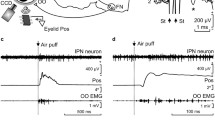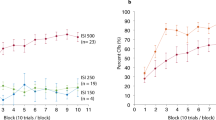Abstract
To elucidate whether the cerebellar cortex may contribute to trace eyeblink conditioning in humans, eight patients with degenerative cerebellar disorders (four with sporadic adult onset ataxia, three with autosomal dominant cerebellar ataxia type III and one with spinocerebellar ataxia type 6) and eight age- and sex-matched healthy control subjects were investigated. Individual high resolution three-dimensional MRI data sets were acquired. As revealed by volumetric measurements of the cerebellum using ECCET software, patients showed cerebellar atrophy to various degrees. No abnormalities were observed in the control subjects. Eyeblink conditioning was performed twice using a tone of 40 ms as conditioned stimulus, followed by a short (400 ms) and a long (1,000 ms) trace interval and an air-puff of 100 ms as unconditioned stimulus. Using the short trace interval, eyeblink conditioning was significantly impaired in cerebellar patients compared to controls, even in those who fulfilled criteria of awareness. Using the long trace interval no significant group differences could be observed. The present findings of impaired trace eyeblink acquisition in patients with cortical cerebellar degeneration suggest that the cerebellar cortex in humans, in addition to the interposed nucleus, is involved in trace eyeblink conditioning, if the trace interval is relatively short. Using a long trace interval, the cerebellum appears to be less important.





Similar content being viewed by others
References
Aksenov D, Serdyukova N, Irwin K, Bracha V (2004) GABA neurotransmission in the cerebellar interposed nuclei: involvement in classically conditioned eyeblinks and neuronal activity. J Neurophysiol 91:719–727
Bloedel JR, Bracha V (1995) On the cerebellum, cutaneomuscular reflexes, movement control and the elusive engrams of memory. Behav Brain Res 68:1–44
Bracha V, Zhao L, Irwin KB, Bloedel JR (2000) The human cerebellum and associative learning: dissociation between the acquisition, retention and extinction of conditioned eyeblinks. Brain Res 860:87–94
Clark RE, Squire LR (1998) Classical conditioning and brain systems: the role of awareness. Science 280:77–81
Christian KM, Thompson RF (2003) Neural substrates of eyeblink conditioning: acquisition and retention. Learn Mem 11:427–455
Dimitrova A, Zeljko D, Schwarze F, Maschke M, Gerwig M, Frings M, Beck A, Aurich V, Forsting M, Timmann D (2006) Probabilistic 3D MRI atlas of the human cerebellar dentate/interposed nuclei. NeuroImage 30:12–25
Finkbiner RG, Woodruff-Pak DS (1991) Classical eyeblink conditioning in adulthood: effects of age and interstimulus interval on acquisition in the trace paradigm. Psychol Aging 6:109–117
Fortier CB, Disterhoft JF, McGlinchey-Berroth R (2000) Cerebellar cortical degeneration disrupts discrimination learning but not delay or trace classical eyeblink conditioning. Neuropsychology 14:537–550
Gerwig M, Dimitrova A, Kolb FP, Maschke M, Brol B, Kunnel A, Böring D, Thilmann AF, Forsting M, Diener HC, Timmann D (2003) Comparison of eyeblink conditioning in patients with superior and posterior inferior cerebellar lesions. Brain 126:71–94
Gerwig M, Dimitrova A, Maschke M, Kolb FP, Forsting M, Timmann D (2004) Amplitude changes of unconditioned eyeblink responses in patients with cerebellar lesions. Exp Brain Res 155:341–351
Gerwig M, Hajjar K, Dimitrova A, Maschke M, Kolb FP, Frings M, Thilmann AF, Forsting M, Diener HC, Timmann D (2005) Timing of conditioned eyeblink responses is impaired in cerebellar patients. J Neurosci 25:3919–3931
Gerwig M, Haerter K, Hajjar K, Dimitrova A, Maschke M, Kolb FP, Thilmann AF, Gizewski ER, Timmann D (2006a) Trace eyeblink conditioning in human subjects with cerebellar lesions. Exp Brain Res 170:7–21
Gerwig M, Hajjar K, Frings M, Dimitrova A, Thilmann AF, Kolb FP, Forsting M, Timmann D (2006b) Extinction of conditioned eyeblink responses in patients with cerebellar disorders. Neurosci Lett 406:87–91
Gerwig M, Kolb FP, Timmann D (2007) The involvement of the human cerebellum in eyeblink conditioning. Cerebellum 6:38–57
Green JT, Woodruff-Pak DS (2000) Eyeblink classical conditioning: hippocampal formation is for neutral stimulus associations as cerebellum is for association-response. Psychol Bull 126:138–158
Green JT, Arenos JD (2007) Hippocampal and cerebellar single-unit activity during delay and trace eyeblink conditioning in the rat. Neurobiol Learn Mem 87:269–284
Gruart A, Guillazo-Blanch G, Fernandez-Mas R, Jimenez-Diaz L, Delgado-Garcia JM (2000) Cerebellar posterior interpositus nucleus as an enhancer of classically conditioned eyelid responses in alert cats. J Neurophysiol 84:2680–2690
James GO, Hardiman MJ, Yeo CH (1987) Hippocampal lesions and trace conditioning in the rabbit. Behav Brain Res 23:109–116
Kim JJ, Clark RE, Thompson RF (1995) Hippocampectomy impairs the memory of recently, but not remotely, acquired trace eyeblink conditioned responses. Behav Neurosci 109:195–203
Kimble GA, Reynolds B (1967) Eyeblink conditioning as a function of the interval between the conditioned and unconditioned stimuli. In: Kimble GA (ed) Foundations of conditioning and learning. Appleton-Century-Crofts, New York, pp 279–287
Kirsch P, Achenbach C, Kirsch M, Heinzmann M, Schienle A, Vaitl D (2003) Cerebellar and hippocampal activation during eyeblink conditioning depends on the experimental paradigm: a MEG study. Neural Plasticity 10:291–301
Kishimoto Y, Kawahara S, Suzuki M, Mori H, Mishina M, Kirino Y (2001) Classical eyeblink conditioning in glutamate receptor subunit delta 2 mutant mice is impaired in the delay paradigm but not in the trace paradigm. Eur J Neurosci 13:1249–1253
Koekkoek SK, Hulscher HC, Dortland BR, Hensbroek RA, Elgersma Y, Ruigrok TJ, De Zeeuw CI (2003) Cerebellar LTD and learning dependent timing of conditioned eyelid responses. Science 301:1736–1739
Kronenbuerger M, Gerwig M, Brol B, Block F, Timmann D (2007) Eyeblink conditioning is impaired in subjects with essential tremor. Brain 130:1538–1551
Lipkin SG, Moore JW (1966) Eyelid trace conditioning, CS intensity, CS-UCS interval, and a correction for “spontaneous” blinking. J Exp Psychol 72:216–220
Manns JR, Clark RE, Squire LR (2000) Awareness predicts the magnitude of single-cue trace eyeblink conditioning. Hippocampus 10:181–186
McGlinchey-Berroth R, Carrillo MC, Gabrieli JD, Brawn CM, Disterhoft JF (1997) Impaired trace eyeblink conditioning in bilateral, medial-temporal lobe amnesia. Behav Neurosci 111:873–882
Moyer JR Jr, Deyo RA, Disterhoft JF (1990) Hippocampectomy disrupts trace eye-blink conditioning in rabbits. Behav Neurosci 104:243–252
Perrett SP, Ruiz BP, Mauk MD (1993) Cerebellar cortex lesions disrupt learning-dependent timing of conditioned eyelid responses. J Neurosci 13:1708–1718
Perrett SP, Mauk MD (1995) Extinction of conditioned eyelid responses requires the anterior lobe of cerebellar cortex. J Neurosci 15:2074–2080
Plakke B, Freeman JH, Poremba A (2007) Metabolic mapping of the rat cerebellum during delay and trace eyeblink conditioning. Neurobiol Learn Mem 88:11–18
Port RL, Romano AG, Steinmetz JE, Mikhail AA, Patterson MM (1986) Retention and acquisition of classical trace conditioned responses by rabbits with hippocampal lesions. Behav Neurosci 100:745–752
Reynolds B (1945) The acquisition of a trace conditioned response as a function of the magnitude of the stimulus trace. J Exp Psychol 35:15–30
Richter S, Dimitrova A, Hein-Kropp C, Wilhelm H, Gizewski E, Timmann D (2005) Cerebellar agenesis II: motor and language functions. Neurocase 11:103–113
Robleto K, Poulos AM, Thompson RF (2004) Brain mechanisms of extinction of the classically conditioned eyeblink response. Learn Mem 11:517–524
Schmitz-Hübsch T, du Montcel ST, Baliko L, Berciano J, Boesch S, Depondt C, Giunti P, Globas C, Infante J, Kang JS, Kremer B, Mariotti C, Melegh B, Pandolfo M, Rakowicz M, Ribai P, Rola R, Schols L, Szymanski S, van de Warrenburg BP, Durr A, Klockgether T, Fancellu R (2006) Scale for the assessment and rating of ataxia: development of a new clinical scale. Neurology 66:1717–1720
Solomon PR, Van der Schaaf ER, Thompson RF, Weisz DJ (1986) Hippocampus and trace conditioning of the rabbit’s classically conditioned nictitating membrane response. Behav Neurosci 100:729–744
Takehara K, Kawahara S, Kirino Y (2003) Time-dependent reorganization of the brain components underlying memory retention in trace eyeblink conditioning. J Neurosci 23:9897–9905
Thompson RF, Bao S, Chen L, Cipriano BD, Grethe JS, Kim JJ, Thompson JK, Tracy JA, Weninger MS, Krupa DJ (1997) Associative learning. Int Rev Neurobiol 41:151–189
Topka H, Valls-Sole J, Massaquoi SG, Hallett M (1993) Deficit in classical conditioning in patients with cerebellar degeneration. Brain 116:961–969
Timmann D, Gerwig M, Frings M, Maschke M, Kolb FP (2005) Eyeblink conditioning in patients with hereditary ataxia: a one year follow-up study. Exp Brain Res 162:332–345
Trouillas P, Takayanagi T, Hallett M, Currier RD, Subramony SH, Wessel K, Bryer A, Diener HC, Massaquoi S, Gomez CM, Coutinho P, Ben Hamida M, Campanella G, Filla A, Schut L, Timmann D, Honnorat J, Nighoghossian N, Manyam B (1997) International Cooperative Ataxia Rating Scale for pharmacological assessment of the cerebellar syndrome. The Ataxia Neuropharmacology Committee of the World Federation of Neurology. J Neurol Sci 145:205–211
Tseng W, Guan R, Disterhoft JF, Weiss C (2004) Trace eyeblink conditioning is hippocampally dependent in mice. Hippocampus 14:58–65
Weiss C, Bouwmeester H, Power JM, Disterhoft JF (1999) Hippocampal lesions prevent trace eyeblink conditioning in the freely moving rat. Behav Brain Res 99:123–132
Woodruff-Pak DS, Lavond DG, Thompson RF (1985) Trace conditioning: abolished by cerebellar nuclear lesions but not lateral cerebellar cortex aspirations. Brain Res 348:249–260
Woodruff-Pak DS, Papka M, Ivry RB (1996) Cerebellar involvement in eyeblink classical conditioning in humans. Neuropsychology 10:443–458
Woodruff-Pak DS, Green JT, Levin SI, Meisler MH (2006) Inactivation of sodium channel Scn8A (Na-sub(v)1.6) in Purkinje neurons impairs learning in Morris water maze and delay but not trace eyeblink classical conditioning. Behav Neurosci 120:229–240
Acknowledgments
We would like to thank Dr. Albena Dimitrova for performance and analysis of brain imaging and Beate Brol for her help in eyeblink data analysis and preparation of the figures. The study was supported by a grant of the Bernd Fink Foundation.
Author information
Authors and Affiliations
Corresponding author
Rights and permissions
About this article
Cite this article
Gerwig, M., Eßer, A.C., Guberina, H. et al. Trace eyeblink conditioning in patients with cerebellar degeneration: comparison of short and long trace intervals. Exp Brain Res 187, 85–96 (2008). https://doi.org/10.1007/s00221-008-1283-2
Received:
Accepted:
Published:
Issue Date:
DOI: https://doi.org/10.1007/s00221-008-1283-2




